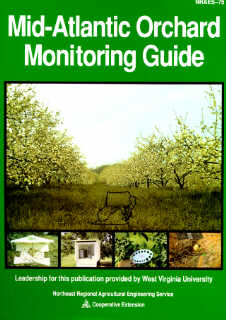 The Virginia Fruit Web Site:
The Virginia Fruit Web Site:
Apple IPM
Updated 15 February 2025
Pest Biology | Trap Data | Biological
Control | Chemical Control | Mating Disruption
Pest Insect and Disease Biology and
Monitoring
- Order
Mid-Atlantic Orchard Monitoring Guide
- Biological and monitoring information
for orchard arthropods:
- Direct Pests of Apple -
affecting the fruit directly
- Internal Feeders
- External Feeders
- Indirect Pests of Apple -
affecting other parts of the tree (leaves, shoots, etc.)
- Most of the preceding pest files
reprinted with permission from Mid-Atlantic Orchard
Monitoring Guide, published by NRAES, 152 Riley-Robb
Hall, Ithaca, New York 14853-5701. (607) 255-7654
Tree Fruit Pests of the Month!
Current pheromone trap data for selected pome fruit pests
- Virginia Counties:
- 2010: Madison (see Graves Apple
and Peach
data), Rappahannock, Winchester
- 2009: Madison (see Graves Apple
and Peach
data), Rappahannock, Winchester
- 2008: Montgomery,
Madison (see Graves Apple
and Peach
data), Nelson, Rappahannock, Winchester
- 2007: Montgomery,
Madison (see Graves Apple
and Peach
data), Nelson, Rappahannock, Winchester
- 2006: Montgomery,
Madison (see Graves Apple
and Peach
data), Nelson, Rappahannock, Winchester
- 2005: Albemarle,
Amherst, Botetourt, Montgomery, Madison (see
Graves Apple
and Peach
data), Nelson, Rappahannock, Winchester
- 2004: Albemarle,
Amherst,
Botetourt,
Montgomery,
Madison (see Graves Apple
and Peach
data), Nelson,
Rappahannock,
Winchester
- 2003: Albemarle,
Amherst,
Botetourt,
Montgomery,
Madison (see Graves Apple
and Peach
data), Nelson,
Rappahannock,
Winchester
- 2002: Albemarle
(Covesville;Miller
School), Amherst,
Botetourt,
Montgomery
(also see 2001), Nelson,
Patrick,
Rappahannock
- Mating Disruption trap shutdown (2005,
2004,
2003,
2002)
- West Virginia
Degree-day use and interpretation for growers
Degree-day targets for CM, OFM and TBM
Information on an apple maggot export protocol
An illustrated diagnostic key to tree
fruit diseases (West Virginia University)
Biological and monitoring information for apple diseases:
The Orchard Monitor, a biweekly newsletter on fruit IPM from West Virginia University
En español: El Manual de
Monitoreo de Plagas, Enemigos Naturales y Enfermidades del
Manzano, Peral y Cerezo: Una Guia Ilustrada para el estado
de Washington (Orchard Monitoring Manual for Pests,
Natural Enemies and Diseases of Apple, Pear and Cherry: An
Illustrated Guide for Washington State)
Biological Control
- Predators of Mites and Aphids Reprinted with permission from Mid-Atlantic Orchard Monitoring Guide, published by NRAES, 152 Riley-Robb Hall, Ithaca, New York 14853-5701. (607) 255-7654
- Toxicity to Orchard Predators from Pesticides [from 2022 Spray Bulletin for Commercial Tree Fruit Growers (Virginia, West Virginia and Maryland Coop. Ext. Pub. 456-419)]
- Commercial sources of natural enemies
- Entomopathogenic Nematodes
Chemical Control
- Your Nearest Poison Control Center - (800) 222-1222
- Control Recommendations
(,
because pest species and recommended controls vary regionally.
Recommendations for commercial use and home use are made
separately for specific reasons. Many pesticides used by
commercial growers require applicators to be certified; these
may not legally be purchased or applied by non-certified
applicators. Materials recommended for home fruit production
are safer for application in the typical homeowner
environment.).
- To buy hard
copies of Virginia Tech Recommendations
Links to Virginia Chemical Control Recommendations:
The guides are available free online
in PDF, and will also be available for purchase.
- 2025 Pest Management Guides
- Toxicity to Orchard Predators from Pesticides [from 2019 Spray
Bulletin for Commercial Tree Fruit Growers (Virginia
and West Virginia Coop. Ext. Pub. 456-419)]
- Efficacy to Apple
Pests of Pesticides [from 2022 Spray Bulletin for Commercial
Tree Fruit Growers (Virginia and West Virginia Coop. Ext. Pub.
456-419)]
- Toxicity to Honey Bees of Fruit Insecticides [from 2022 Spray Bulletin for Commercial
Tree Fruit Growers (Virginia and West Virginia Coop. Ext. Pub.
456-419)]
- Insecticide Resistance Management (Breeze)
- EPA Text on Pesticide Poisoning
- Airblast spraying
- Environmental Impact Quotient, developed at Cornell University to
determine the environmental impact of orchard insecticides
(updated July 2003)
- Pesticide legislation - Federal
Insecticide, Fungicide and Rodenticide Act (FIFRA)
(U. S. Senate web links)
Weed Management
Pheromone-based Monitoring and
Management
- Information on establishing a disruption block in orchards or vineyards
- Mating disruption
for codling moth
- Labels for mating disruption products
- Codling moth: Isomate
C-TT, sprayable Suterra's Checkmate
CM-F), Suterra's CM and OFM Puffers, Isomate CM/OFM TT,
SPLAT Cydia,
- Oriental fruit moth: SPLAT
OFM, Isomate-M Rosso, Isomate CM/OFM TT,
- Dogwood borer: Isomate DWB
(dogwood borer),
- Peach borers: Isomate Dual,
- Grape berry moth: SPLAT GBM, Isomate Plus (discont.),
- Grape root boarer: Isomate GRB,
- Miscellaneous: SPLAT
Tuta, SPLAT GM, SPLAT GM Organic, SPLAT with spinosad, diamondback moth Checkmate
DBM-F) (note formulations - impact on OMRI?)
Pacific Biocontrol Mating Disruption Information
Hercon
Environmental
Washington State University page on codling moth mating disruption.
Pherolist,
a glossary of lepidopteran sex attractants
Resistant Varieties
Other Topics
 The Virginia Fruit Web Site:
The Virginia Fruit Web Site: